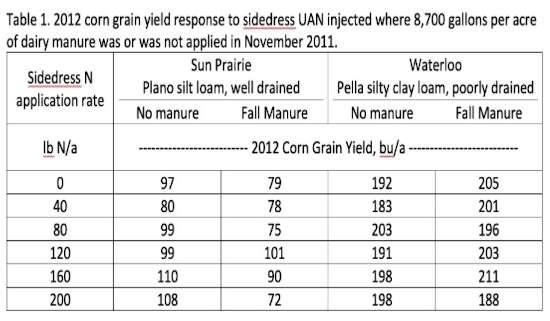By Carrie Laboski
It has been abnormally dry throughout much of Wisconsin this spring. Current weather forecasts are for hot and dry conditions to persist for at least the next 10 days. A few farmers and agronomists have asked if they should make any changes to their corn sidedress N application plans based on the current, and forecasted, weather. Below are a few things to consider.
Urea or urea ammonium nitrate (UAN) are the most common sidedress N sources. Nitrogen loss through ammonia volatilization of urea is enhanced when the following conditions occur:
- High temperature.
- There is no rain after application. Ammonia volatilization losses will be low if 0.1 to 0.2 inches of rainfall occur with 2 to 4 days after urea application, when temperatures are 50° to 70°. If there is no rainfall with 5 days, ammonia losses may be significant.
- Soil pH > 7.0.
- Relative humidity of 50 to 90 %.
- Low soil organic matter and low clay content. Volatilization losses are more likely on sandy soils because they have a lower ability to retain ammonium on the cation exchange.
- Greater surface residue.
Research at Lancaster and Arlington Ag Research Stations found that when urea was surface applied during warm weather, 19% of the N was lost as ammonia within two days of application (Oberle and Bundy, 1984). During warm weather, rainfall within one day of urea application is needed to limit ammonia volatilization.
Urease inhibitors (e.g. active ingredients include NBPT, Duromide, NPPT; products include Agrotain, Anvol, Limus) can be used with surface applied urea to prevent decomposition of urea and volatilization of ammonia. Urease inhibitors extend the period of time between urea application and when significant N losses occur. This provides a greater opportunity for rainfall to occur during this longer time frame. Given the current weather conditions and forecast, a urease inhibitor should strongly be considered for all surface applied urea or UAN.
Fifty percent of the N in UAN is in the form of urea, therefore 50% of the N is subject to volatilization loss and would benefit from the use of a urease inhibitor if surface applied. The amount of urease inhibitor used with UAN is typically half the amount used with urea, because only 50% of the N in UAN needs protection. If UAN is knifed in, and the soil closes behind the knife, then a urease inhibitor is likely unnecessary. Cultivation of urea or UAN into the soil, would also likely limit ammonia volatilization.
Consider delaying sidedress application by a few days when there is no rain and high temperatures are forecast. The purpose of delaying application is to reduce the length of time urea is on the soil surface before rainfall occurs. The length of time you delay application will depend upon the height of the crop and the application equipment available. Sidedress applications at V9 have been successfully used in Wisconsin where 40 lb N/a was applied at planting.
In drought conditions, water limits corn growth and yield more than N. In 2012, we found no yield increase to sidedress N fertilizer (Table 1) where dairy manure was or was not applied the prior fall. Shortly after sidedressing rainfall was very limited and drought conditions persisted for weeks. The poorly drained soil in Waterloo yielded better under drought conditions than the well-drained soil in Sun Prairie.
 When finalizing a decision regarding sidedress N rate, remember that spring and fall and spring manure applications will supply N. A pre-sidedress nitrate soil test (PSNT) can be used to evaluate manure or forage legume N credits. For more information about the PSNT see: https://ipcm.wisc.edu/download/pubsNM/UWSoilNitrateTests_final.pdf With extended dry conditions in the forecast, consider reducing the sidedress N application rate to limit input costs that may have no return. If it does begin to rain in a few weeks, it is possible to make a second N application if needed, assuming equipment is available to go over an even tall crop.
When finalizing a decision regarding sidedress N rate, remember that spring and fall and spring manure applications will supply N. A pre-sidedress nitrate soil test (PSNT) can be used to evaluate manure or forage legume N credits. For more information about the PSNT see: https://ipcm.wisc.edu/download/pubsNM/UWSoilNitrateTests_final.pdf With extended dry conditions in the forecast, consider reducing the sidedress N application rate to limit input costs that may have no return. If it does begin to rain in a few weeks, it is possible to make a second N application if needed, assuming equipment is available to go over an even tall crop.
Source : wisc.edu